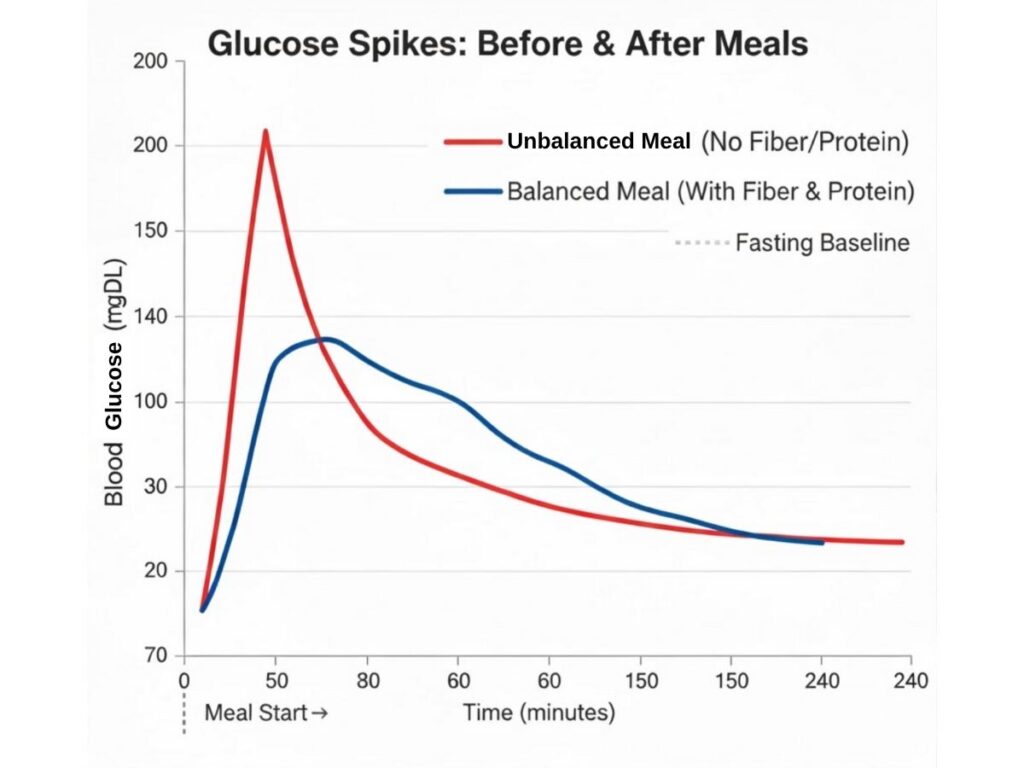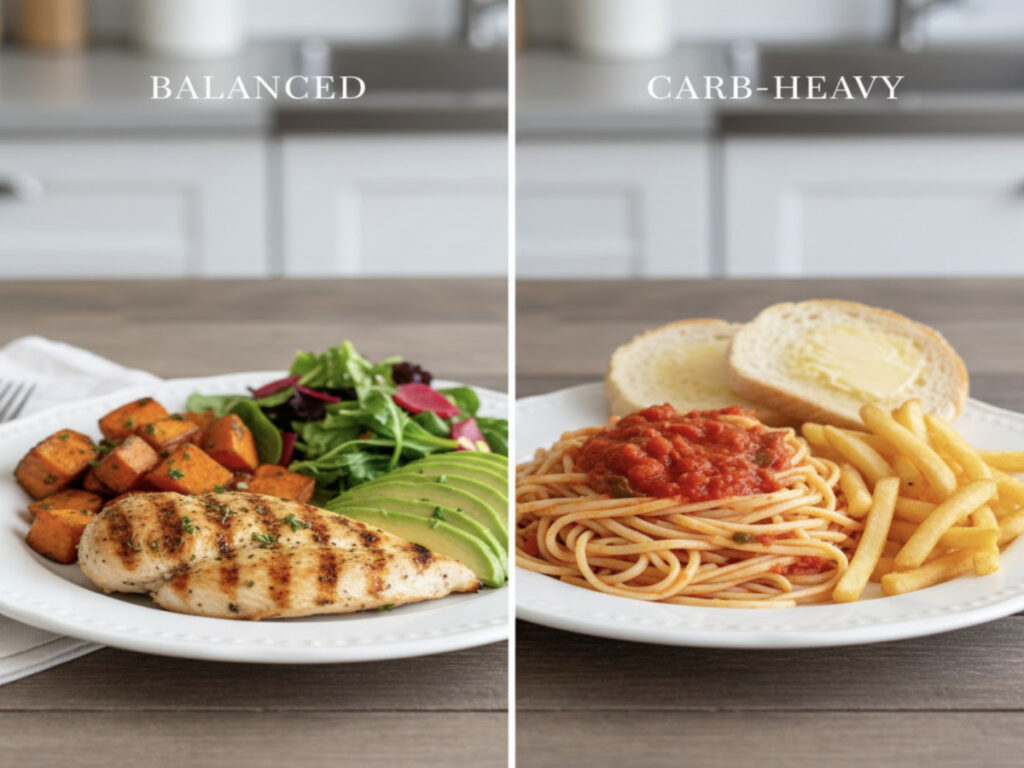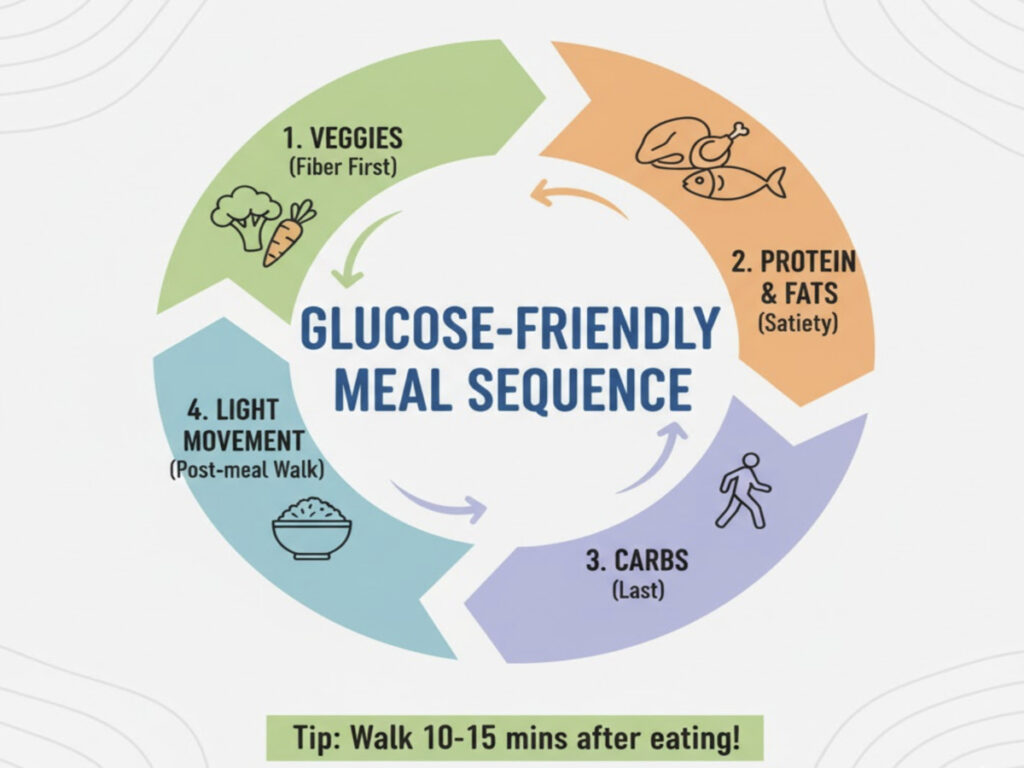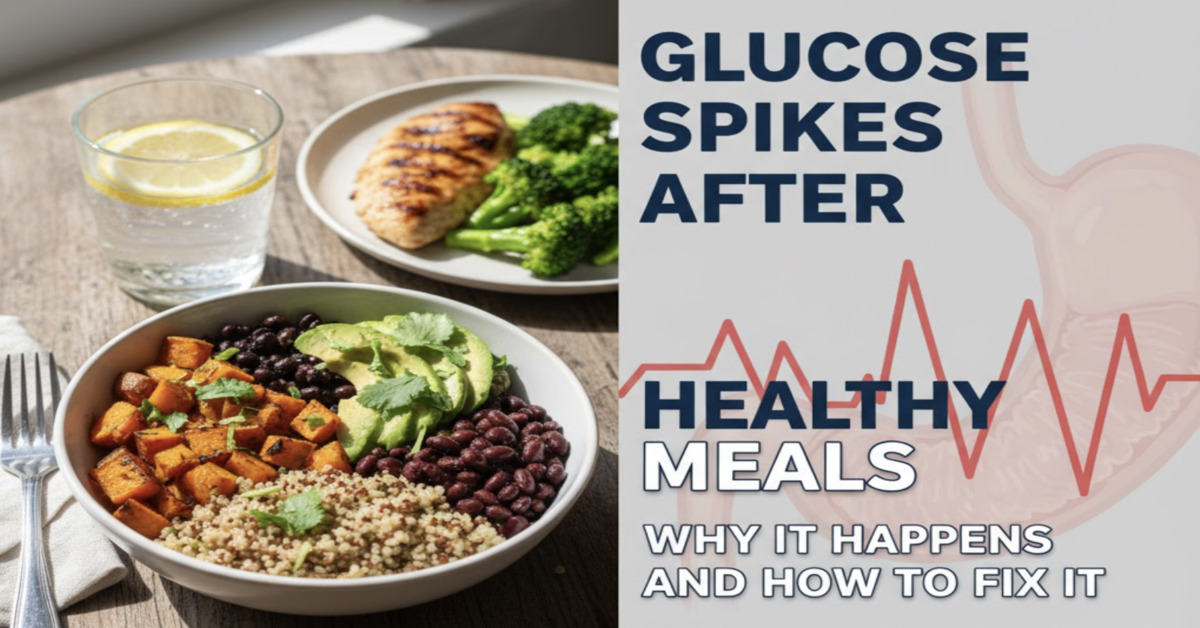Introduction: The Surprising Truth About “Healthy” Meals
Imagine eating a bowl of oatmeal with fruit or a quinoa salad — both considered healthy — only to feel sluggish or hungry an hour later.
If this sounds familiar, you’ve likely experienced a glucose spike, even from a “clean” meal.
Glucose spikes aren’t just a diabetic issue — they affect energy, mood, cravings, and fat storage for everyone.
In 2025, wearable glucose monitors have revealed something shocking: even healthy meals can trigger large blood sugar swings, undermining wellness goals.

Understanding Post-Meal Glucose Spikes
A glucose spike is a rapid rise in blood sugar levels that occurs after eating.
When we eat carbohydrates, they break down into glucose — our body’s main energy source.
Insulin helps move that glucose into cells for energy or storage.
However, when glucose enters the bloodstream too quickly, insulin surges, leading to:
- Energy crashes
- Increased hunger
- Fat storage
- Inflammation and oxidative stress
Statistic: A 2024 study from Stanford University’s Nutritional Genomics Lab found that over 80% of healthy adults experience at least one major glucose spike daily.
Why Even Healthy Foods Can Cause Blood Sugar Surges
Even nutrient-rich meals can lead to spikes depending on timing, food combinations, and individual metabolism.
Here’s why:
1. Low Fiber or Protein Balance
Foods like smoothies or acai bowls may look healthy but lack fiber or protein, causing rapid glucose absorption.
2. Cooking and Processing Methods
Cooking carrots or oats increases their glycemic index, making them faster to digest and spike glucose faster.
3. Meal Timing
Eating carbohydrates on an empty stomach can cause bigger spikes compared to pairing them with fat or protein.
4. Individual Variability
Genetics, gut microbiome, and sleep quality affect how your body handles glucose.

The Role of Gut Health and Insulin Sensitivity
Your gut microbiome plays a major role in how your body metabolizes carbs.
A diverse microbiome helps regulate insulin response and slow glucose absorption.
Meanwhile, insulin sensitivity — how responsive your cells are to insulin — determines how quickly glucose clears from your bloodstream.
Factors that lower insulin sensitivity include:
- Poor sleep
- Chronic stress
- Inactivity
- Processed food diets
Expert Quote:
“You can eat the same meal as someone else and have completely different glucose responses — that’s how powerful gut and metabolic individuality are.”
— Dr. Alicia Grant, Metabolic Health Researcher, Harvard T.H. Chan School of Public Health
Hidden Factors That Magnify Glucose Spikes
- Lack of sleep: Increases cortisol, which raises fasting glucose.
- Sedentary behavior: Sitting after eating worsens blood sugar clearance.
- Stress: Activates adrenaline and cortisol, pushing up glucose.
- Liquid calories: Smoothies, fruit juices, or even oat milk can rapidly raise glucose.
Statistic: The American Diabetes Association (2025) notes that walking for 10 minutes post-meal can lower glucose spikes by up to 22%.
The Science Behind Glucose Variability and Metabolic Health
Glucose variability — the up-and-down swings in blood sugar — is emerging as a key predictor of long-term health.
Even in non-diabetic individuals, large glucose fluctuations are linked to:
- Fatigue and brain fog
- Weight gain
- Accelerated aging (via glycation and oxidative stress)
- Increased cardiovascular risk
Stabilizing glucose is not about eliminating carbs, but about training your metabolism for smoother responses.
Actionable Strategies to Reduce Post-Meal Glucose Spikes
- Eat fiber, fat, or protein before carbs
– Example: Start with veggies, then protein, and carbs last. - Add vinegar before meals
– 1 tbsp apple cider vinegar in water helps lower post-meal glucose by improving insulin sensitivity. - Move after eating
– A 10-minute walk or light stretching reduces spikes dramatically. - Avoid naked carbs
– Never eat carbs alone (like fruit or toast). Always pair them with protein or fat. - Sleep 7–8 hours nightly
– Poor sleep worsens insulin response the next day. - Stay hydrated
– Water helps move glucose from blood into cells more efficiently.

Best Food Pairings to Flatten Glucose Curves
| Carbohydrate Food | Pairing for Glucose Control | Why It Works |
|---|---|---|
| Oatmeal | Add chia seeds + Greek yogurt | Adds fiber and protein to slow absorption |
| Fruit (apple, banana) | Pair with peanut butter or nuts | Fat slows sugar entry |
| Rice or pasta | Combine with chicken and veggies | Protein lowers GI impact |
| Smoothie | Include spinach, protein powder, flaxseeds | Reduces sugar absorption |
| Bread or toast | Add avocado or eggs | Provides fat and protein for balance |
Smart Eating Order: A Proven Hack for Blood Sugar Control
Recent studies show that meal order matters almost as much as the meal itself.
Eating fiber and protein first, followed by carbs, can lower glucose spikes by up to 70%.
Example:
Instead of eating rice first, start with salad and chicken, then have rice last.
This sequence slows glucose release and minimizes insulin demand.
Expert Insight:
“It’s not about cutting carbs. It’s about mastering the timing and composition of meals.”
— Dr. Michael Rhodes, Endocrinologist, Mayo Clinic
Practical Checklist for Glucose Stability
☑ Include fiber, protein, or fat with every meal
☑ Eat in the right order: veggies → protein → carbs
☑ Add apple cider vinegar before meals
☑ Move for 10–15 minutes after eating
☑ Avoid sugary beverages and “naked carbs”
☑ Prioritize sleep and manage stress daily
Common Myths & FAQ
Q1: Can healthy foods really cause glucose spikes?
A: Yes. Even oats, rice, and fruit can spike blood sugar if eaten alone or too quickly.
Q2: Do I need a glucose monitor to fix spikes?
A: No, but using a CGM for a few weeks can help you understand your personal responses.
Q3: Is it bad to have occasional spikes?
A: Occasional spikes are normal — chronic, repetitive spikes cause metabolic issues.
Q4: Can vinegar or lemon water really help?
A: Yes. Acetic acid improves insulin sensitivity and slows glucose absorption.
Authoritative Resources
- American Diabetes Association – Blood Glucose Monitoring & Management
- Harvard Health Publishing – Understanding Blood Sugar Swings
- National Institute of Diabetes and Digestive and Kidney Diseases – Glucose & Insulin Basics
Other Interesting Articles
- Metabolic Damage Recovery: The Science of Repairing Your Body After Dieting Too Hard
- Blood Sugar Cycling: A Novel Approach to Energy Balance and Metabolic Health
Conclusion & Call-to-Action
Glucose spikes are not just a number on a monitor — they’re a real-time reflection of metabolic health.
Even “healthy” meals can backfire if eaten without balance or awareness.
The fix isn’t complicated — it’s strategic: pair your carbs, move a little, and eat smartly.
When you master glucose control, you’ll unlock steady energy, better mood, and long-term wellness — without giving up the foods you love.
Next Step:
Start implementing one glucose-friendly habit this week — try eating veggies first or walking after meals. Within days, you’ll feel the difference in energy and focus.

